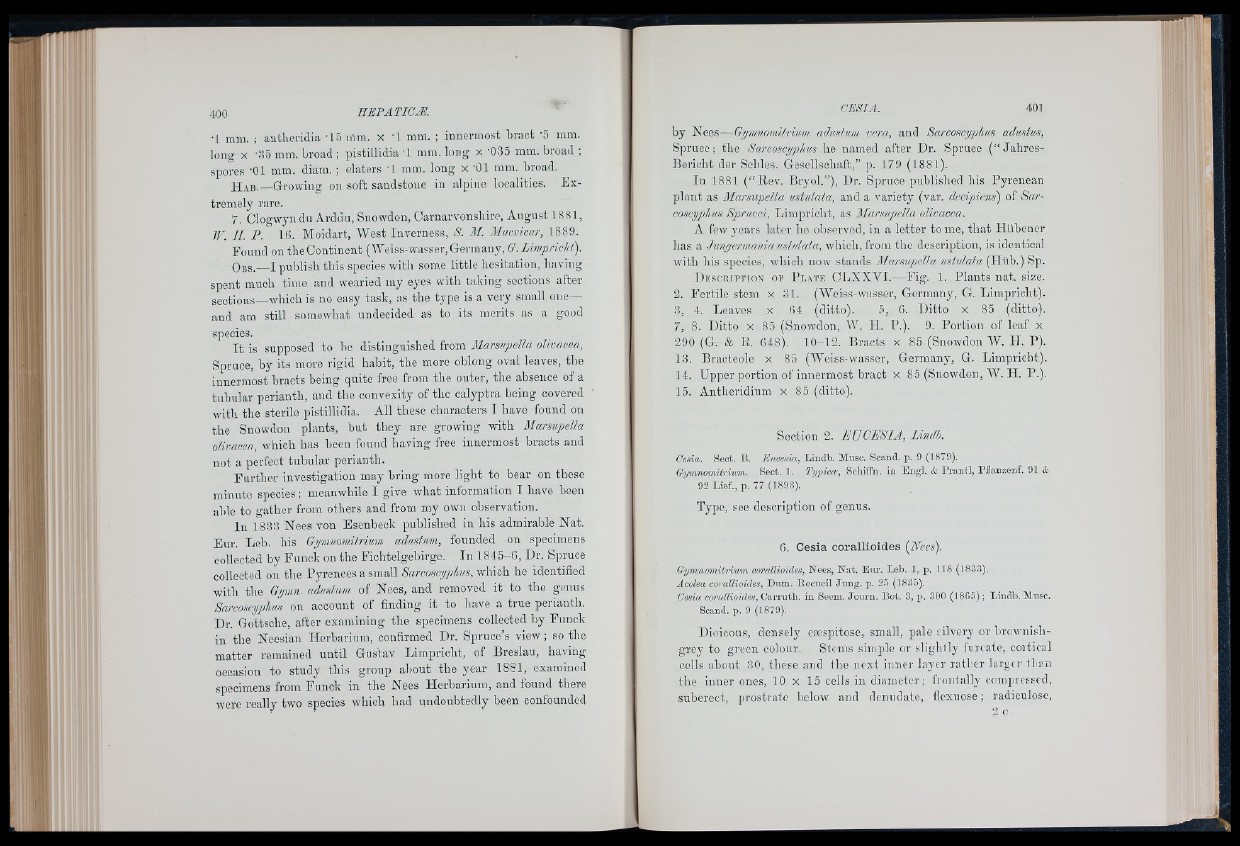
•I. mm. ; antheridia '15 mm. x T mm. ; innermost braot A mm.
long x -35 mm. broad ; pistillidia T mm. long x ’035 mm. broad ;
spores -01 mm. diam. ; elaters T mm. long x '01 mm. broad.
H . a b . Grovving on soft sandstone in alpine localities. Extremely
rare.
7. Clogwyn du Arddu, Snowdon, Carnarvonshire, August 1881,
IF. II. P. IG. Moidart, West Inverness, S. M. Macvicar, 1889.
Found on the Continent (Weiss-vvasser, Germany, G. Limpricht).
Obs.—I publish this species with some little hesitation, having
spent much time and wearied my eyes with taking sections after
sections—which is no easy task, as the type is a very small one—
and am still somewhat undecided as to its merits as a good
species.
I t is supposed to he distinguished from Marsupella olivácea,
Spruoe, hy its more rigid habit, the more oblong oval leaves, the
innermost bracts being quite free from the outer, the absence of a
tubular perianth, and the convexity of the calyptra being covered
with the sterile pistillidia. All these characters I have found on
the Snowdon plants, but they are growing with Marsupella
olivácea, which has been found having free innermost braots and
not a perfect tubular perianth.
Further investigation may bring more light to bear on these
minute species; meanwhile I give what information I have been
able to gather from others and from my own observation.
In 1833 Nees von Esenbeok published in his admirable Nat.
Eur. Leb. his Gpnmmitrium adustum, founded on specimens
collected by Funck on the Fichtelgebirge. In 1845-6, Dr. Spruce
collected on the Pyrenees a small Sarcoscyphus, which he identified
with the Gjjnm. ndusfum of Nees, and removed it to the genus
Sarcoscyphus on account of finding it to have a true perianth.
Dr. Gottsche, after examining the specimens oolleoted hy Funck
in the Neesian Herbarium, confirmed Dr. Spruce’s view; so the
matter remained until Gustav Limpricht, of Breslau, having
occasion to study this group about the year 1881, examined
specimens from Funok in the Nees Herbarium, and found there
were really two species which had undoubtedly been confounded
by Nees— Gymiiomilrium aduslum vera, and Sarcoscyphccs adustus,
Sqiruce; the Sarcoscyphus he named after Dr. Spruce (“ Jahres-
Bericht der Schles. Gesellschaft,” p. 179 (1881).
In 1881 (“ Rev. Bryol.”), Dr. Spruoe published his Pyrenean
plant as Marsupella -ustulata, and a variety (var. decipiens) of Sarcoscyphus
Sprucei, Limpricht, as Marsupella olivácea.
A few years later he observed, in a letter to me, that Hiihener
has a .Ttinyermanin ushdala, which, from the description, is identical
with his species, which now stands Marsupella nsiulata (Hub.) Sp.
Dkscrii’tion of P la te CLXXVT.—Fig. 1. Plants nat. size.
2. Fertile stem x 31. (Weiss-wasser, Germany, G. Limpriciit).
3, 4. Leaves x 64 (ditto). 5, 6. Ditto x 85 (ditto).
7, 8. Ditto X 85 (Snowdon, W. II. P.). 9. Portion of leaf x
290 (G. & E. 648). 10-12. Braots x 85 (Snowdon W. H. P).
13. Bracteole x 85 (Weiss-wasser, Germany, G. Limpricht).
14. Upper portion of innermost braot x 85 (Snowdon, W. II. P.).
15. Antheridium x 85 (ditto).
Section 2. EÜCESIA, lindh.
Cesia. Sect. B. Encesia, Lindb. Muso. Scand. p. 9 (1879).
Gymnomitrium. Sect. 1. Typicce, Schiffn. in Engl, h P ran il, Pflanzenf. 91 A:
92 Lief., p. 77 (1893).
Type, see description of genus.
6. Cesia corallioid.es (Nees).
Gymnomitrium corallioides, Nees, Nat. Eu r. Leb. 1, p. 118 (1833).
Acolea corallioides, Dum. Eecueil Ju n g . p. 25 (1835).
Cesia corallioides, Carruth. in Seem, Jo n rn . Bot. 8, p. 300 (18G5) ; Lindb. Mnsc.
Scand. p. 9 (1879).
Dioicous, densely cæspitose, small, pale rilvery or brownish-
grey to green colour. Stems simple or slightly ilircate, cortical
cells about 30, these and the next inner layer ratber larger tban
the inner ones, 10 x 15 cells in diameter; frontally compressed,
suberect, prostrate below and denudate, flexuose ; radiculose,
2 c